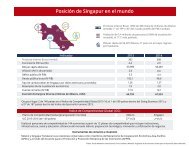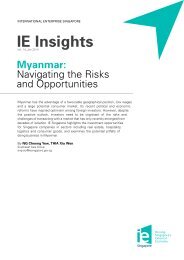basic-guide-to-exporting_Latest_eg_main_086196
basic-guide-to-exporting_Latest_eg_main_086196
basic-guide-to-exporting_Latest_eg_main_086196
You also want an ePaper? Increase the reach of your titles
YUMPU automatically turns print PDFs into web optimized ePapers that Google loves.
Who Is the “Ideal”International Buyer?The short answer: anyone who can afford yourproduct or service and buys it r<strong>eg</strong>ularly. “Ideal”varies according <strong>to</strong> export plan and e-commerc<strong>eg</strong>oals. But r<strong>eg</strong>ardless of your approach, treat allbuyers as if they mean the world <strong>to</strong> you. Picturethe best cus<strong>to</strong>mer service experience you ever hadand deliver something similar—or better.Exporting for the Long TermOne of the biggest complaints we hear frombuyers is that U.S. suppliers drop internationalcus<strong>to</strong>mers when domestic business improves.A weak dollar means goods produced in theU.S. are cheaper for consumers with strongercurrencies; a stronger dollar makes U.S. productsmore expensive, lowering demand if the productisn’t considered essential.For example, in early 2015 European cus<strong>to</strong>merswere paying almost a third more for U.S.-madeproducts. Maybe the products are genuinelyworth the price premium, and buyers will eat thedifference or pass on the cost of the suddenlymore expensive import <strong>to</strong> their cus<strong>to</strong>mers. But inmost cases, such a big price increase will causeyou <strong>to</strong> lose sales.Buyers Have Long MemoriesWhat should you do? Turn away from theinternational market?No. Exchange rate fluctuations are a fact of life,and the most short-sighted thing you can dois abandon international cus<strong>to</strong>mers. When youneed them in the future—when domestic salesare slow and currencies have rebalanced—they’llremember when you s<strong>to</strong>pped answeringtheir messages.Strat<strong>eg</strong>ies for Keeping BuyersR<strong>eg</strong>ardless of changes in currency, it probablycosts you about the same amount <strong>to</strong> sell a unit ofyour product. Show your international buyers youvalue them as cus<strong>to</strong>mers—maybe you can trimfrom your margin so they can afford your product,and in return they’ll reward your flexibility withtheir loyalty. Or, if some of your costs involveimported components, a stronger dollar may makethe components cheaper, enabling you <strong>to</strong> passsavings on <strong>to</strong> buyers in third countries.Find ways <strong>to</strong> make your supply chain moreefficient. If fuel prices drop, shipping costs shouldreduce. And if you and your buyer both savemoney on shipping, you’ll both happy.Consider offering longer payment terms. Priceshock may be cushioned if the buyer has moretime <strong>to</strong> pay. Call your r<strong>eg</strong>ional Ex-Im Bank officefor support with payment terms, as well asprotection against foreign currency losses if youaccept payment in foreign currencies.Help your cus<strong>to</strong>mer lock in lower exchange ratesand order larger quantities (perhaps at a discount)so they won’t need <strong>to</strong> replenish inven<strong>to</strong>ry whenyour product becomes more expensive <strong>to</strong> them.If you treat all your business relationships equallyand please all your cus<strong>to</strong>mers—wherever theyare—your domestic and international business<strong>to</strong>gether will help keep your profits stable.But whatever you do, don’t sit back and waitfor market changes. Take steps now <strong>to</strong> keep thecus<strong>to</strong>mers you have, even while looking for newones who can afford your costlier products.Because while you’re thinking about pulling back,foreign competi<strong>to</strong>rs are getting ready <strong>to</strong> expand.Chapter 6: Finding Qualified Buyers83





